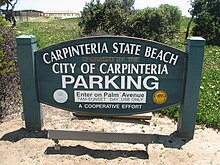Carpinteria Tar Pits
34°23′30.98″N 119°31′16.44″W / 34.3919389°N 119.5212333°W




The Carpinteria Tar Pits (also Carpinteria Oil Seeps) are a series of natural asphalt lakes situated in the southern part of Santa Barbara County in southern California.[1][2]
The Carpinteria Tar Pits are one of the five natural asphalt lake areas in the world, the others being Tierra de Brea in Trinidad and Tobago, Lake Guanoco in Venezuela and the La Brea Tar Pits (Los Angeles) and McKittrick Tar Pits (McKittrick) both also located in the US state of California.[3]
Geography
The Carpinteria Tar Pits are located in the southeastern extremity of Santa Barbara County about 20 km (12 mi) southeast of Santa Barbara in the town of Carpinteria.[1]
The area is a designated park, the Tar Pits Park, and lies within the Carpinteria State Beach area in the southern part between the Santa Rosa and the San Miguel campsites.[1][2] Most of the tar pits are located along a short stretch directly on the beach and generate from the underlying Carpinteria Offshore Oil Field.
Geology
The Carpinteria Tar Pits probably date from the Pleistocene epoch.
The creation of an asphalt lake is typically the result of upwards migrations of hydrocarbons along a geologic fault. Additionally, in connection with subduction pressure can be created against underlying oil source rock.[3][4]
The oil is moving towards the surface and slowly transforming into bitumen; and, on the way through the lithosphere, it is picking up clay and water and is cooled into asphalt.
History
It is unknown when the Carpinteria Tar Pits were discovered, they have been known for a long time by the local Native American Chumash people who mined the asphalt and used it as a sealant for waterproofing their tomols (plank-built boats) and other utilities.[1][2][5]
The area was named "La carpinteria" (carpentry) on August 17, 1769, by a Spanish expedition under explorer Gaspar de Portolà.[2] Starting around 1915 the tar pits were mined and the asphalt was used for building the coastal highway. The tar pits have trapped and preserved hundreds of Pleistocene Age birds and animals but paleontological studies were not conducted as the tar pits later on were used as a local rubbish dump.[2][5]
However some findings are on display at the Carpinteria Valley Museum of History.
In 1933 the area was designated a state beach and in 1941 it was formally opened to the public.[2]
See also
References
- ^ a b c d "Tar Pits Park". Carpinteria.com. Retrieved 2012-03-20.
- ^ a b c d e f "Carpinteria State Beach" (pdf). State of California. Retrieved 2012-03-20.
- ^ a b "Pitch (Asphalt) Lakes of Trinidad, Venezuela, and California". Retrieved 2012-03-20.
- ^ "The Pitch Lake of trinidad". Retrieved 2012-03-20.
- ^ a b "Tar Pits Park". Retrieved 2012-03-20.
